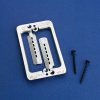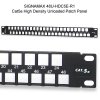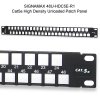After purchasing some required tools, next should be what parts to go after and some considerations. I just NOW figured out how to resize pictures here on IPCT so that helps keep things organized 
Wall brackets:
Made by cutting with your drywall jab saw if going into drywall (if not drywall jab saw, you may have one of those Rotozips that make the job even easier). Can be metal or plastic. 98% of the time, only dealing with single gang faceplates so keeping with this. I am fond of the metal ones. Back in the day, they only had fold down tabs which worked loose after a time. Nowadays, the metal brackets have fold down tabs with long screws to really secure the brackets. Erico caddy MPLS were the top dogs. But now can do cloned version that work identically. Plastic ones work like the blue plastic handyman boxes by tightening top/bottom tabs. I never personally like these as takes longer to hand screw the faceplate screws as compared to the metal brackets. These brackets will accept faceplates (mind you....NOT 110VAC outlets but low voltage related such as coaxial, fiber, audio, HDMI, network jacks, etc). For my personal preference in my house, I wanted all low voltage faceplates to be recessed so the patch cords that are plugged into jacks are never bumped/damaged/broken off. The only solution I really found are the Legrand multimedia recessed ones which also come with a little brush plate for running audio/video cables up into a wall. Unsure of how true this is but a friend electrician said even though it's possible to install electrical outlet on this Legrand bracket, do not as unsafe and possibly not to code. I just used a standard 3 port faceplate in place of the electrical outlet.
In regards to faceplates. You have your standard faceplate and then you have a faceplate that comes with a slit of paper & plastic cover that enables you to label for identification purposes. I prefer the ID faceplate as just looks better in the end. You can do 1, 2, 3, 4, 6 port faceplates. They do make a 12 port faceplate but that requires double gang setup. Many inserts you can add in so do not just think network jacks but future coaxial, HDMI, telephone, etc.





Keystone Cat6 Jacks:
Now is the time to decide on what color jacks you would like to have. I personally went with yellow jacks. At work, our default is orange. You have a wide range of coloring options. I bring up jack color because you could actually be strategic about it. Suppose you are putting 2 cat6 jacks at every faceplate. You could have jack #1 as RED, which goes back to a 24 port RED patch panel. Jack #2 is BLUE, which goes back to a 24port BLUE patch panel. Could make for nice organization when all said and done.
A little nit picking of jacks I have experienced. I really hate those jacks that do NOT have beveled tops on them. It makes it a frustrating struggle to separate your copper pairs and lay them in when you have to do this 24 x 4 pairs = 96 times. Jacks with bevel tops make this a breeze. Most jacks are called Keystone due to the industry standard of using leverage for insertion and removal.


Patch Panels:
This is the 19" wide termination area for your Cat6 cables. Various ways to go about this. Your standard Cat6 patch panel which comes pre-built and ready for termination in the back. Then you have your un-populated patch panels where you insert customized colored keystone jacks (remember the red and blue jacks mentioned above in the faceplates?). Another option is a high density un-populated patch panel where you can fit 48 jacks in a 1U patch panel. 1U is network talk for 1 unit of height for a standard network device such as a netgear 24 port switch. It covers 3 holes on the left, 3 holes on the right in your cabinet or rack. Basically, 1U is 1 3/4". And yes, they do make 2U devices and even 3U devices. The nomenclature of "U" plays an important role if you use a network cabinet or 2 post rack as some network cabinets will say 9U space or 18U space. Real estate is super critical to me so I use the high density patch panel as I have 40+ Cat6 cables ran.



On the wall / Network Wall Cabinets / 2 or 4 post stand up racks:
On the wall network areas have their plus and negatives. Plus: everything is spaced apart which gives more breathing room for organization and easy adding/removing things around as time goes on. Cons: somewhat ghetto if wiring gets out of control which is easy to do if everything sits on the wall. Better to put up a 4'x4' or 4'x8' 3/4" (NOT 1/2" or 3/8"...don't cheap out on this part) backboard that is lag screwed to wall studs which can be painted before use. Another neat thing is easy to use drywall screws to make things secure.
Network Cabinets. Makes things more compacted and organized....looks clean. Various heights (this is where the above mentioned "U" comes into play). Also take note, various depths as well. Some switches or rack mounted battery backups need some serious deep cabinets. 4 or 6 lag bolted to wall studs. Don't even bother using drywall anchors! If you do, please send a picture Additional, cabinets are enclosed which means you can add sound insulation in them, top/bottom mounted fans for airflow (heat DOES happen inside enclosed cabinets), lockable. Some only have front doors you can open to get access to the inside. Some, swing on hinges on the backend that allow you to get to your equipment from behind. Take note: usually can have 2" vertical EMT conduit from above into the cabinet base and the front of the cabinet swings open. This is great if you have to add additional cabling down the road.
Additional, cabinets are enclosed which means you can add sound insulation in them, top/bottom mounted fans for airflow (heat DOES happen inside enclosed cabinets), lockable. Some only have front doors you can open to get access to the inside. Some, swing on hinges on the backend that allow you to get to your equipment from behind. Take note: usually can have 2" vertical EMT conduit from above into the cabinet base and the front of the cabinet swings open. This is great if you have to add additional cabling down the road.
Stand off brackets: used on back board setups to install your patch panels and even rack mounted switches.
Open racks: these are not enclosed but gives access to get behind of things really easily. You have static ones which do not move at all, then you have swing gate ones which swings your equipment out on hinges. Of course, heat is not a problem here. Sound or unsecured equipment is.
2 post racks (will not tackle 4 post server racks here): fantastic if you need vertical space for tons of equipment





That's all for rough draft of parts for this Tuesday. Still have to tackle patch cords and RJ45 modular crimps.
Wall brackets:
Made by cutting with your drywall jab saw if going into drywall (if not drywall jab saw, you may have one of those Rotozips that make the job even easier). Can be metal or plastic. 98% of the time, only dealing with single gang faceplates so keeping with this. I am fond of the metal ones. Back in the day, they only had fold down tabs which worked loose after a time. Nowadays, the metal brackets have fold down tabs with long screws to really secure the brackets. Erico caddy MPLS were the top dogs. But now can do cloned version that work identically. Plastic ones work like the blue plastic handyman boxes by tightening top/bottom tabs. I never personally like these as takes longer to hand screw the faceplate screws as compared to the metal brackets. These brackets will accept faceplates (mind you....NOT 110VAC outlets but low voltage related such as coaxial, fiber, audio, HDMI, network jacks, etc). For my personal preference in my house, I wanted all low voltage faceplates to be recessed so the patch cords that are plugged into jacks are never bumped/damaged/broken off. The only solution I really found are the Legrand multimedia recessed ones which also come with a little brush plate for running audio/video cables up into a wall. Unsure of how true this is but a friend electrician said even though it's possible to install electrical outlet on this Legrand bracket, do not as unsafe and possibly not to code. I just used a standard 3 port faceplate in place of the electrical outlet.
In regards to faceplates. You have your standard faceplate and then you have a faceplate that comes with a slit of paper & plastic cover that enables you to label for identification purposes. I prefer the ID faceplate as just looks better in the end. You can do 1, 2, 3, 4, 6 port faceplates. They do make a 12 port faceplate but that requires double gang setup. Many inserts you can add in so do not just think network jacks but future coaxial, HDMI, telephone, etc.





Keystone Cat6 Jacks:
Now is the time to decide on what color jacks you would like to have. I personally went with yellow jacks. At work, our default is orange. You have a wide range of coloring options. I bring up jack color because you could actually be strategic about it. Suppose you are putting 2 cat6 jacks at every faceplate. You could have jack #1 as RED, which goes back to a 24 port RED patch panel. Jack #2 is BLUE, which goes back to a 24port BLUE patch panel. Could make for nice organization when all said and done.
A little nit picking of jacks I have experienced. I really hate those jacks that do NOT have beveled tops on them. It makes it a frustrating struggle to separate your copper pairs and lay them in when you have to do this 24 x 4 pairs = 96 times. Jacks with bevel tops make this a breeze. Most jacks are called Keystone due to the industry standard of using leverage for insertion and removal.


Patch Panels:
This is the 19" wide termination area for your Cat6 cables. Various ways to go about this. Your standard Cat6 patch panel which comes pre-built and ready for termination in the back. Then you have your un-populated patch panels where you insert customized colored keystone jacks (remember the red and blue jacks mentioned above in the faceplates?). Another option is a high density un-populated patch panel where you can fit 48 jacks in a 1U patch panel. 1U is network talk for 1 unit of height for a standard network device such as a netgear 24 port switch. It covers 3 holes on the left, 3 holes on the right in your cabinet or rack. Basically, 1U is 1 3/4". And yes, they do make 2U devices and even 3U devices. The nomenclature of "U" plays an important role if you use a network cabinet or 2 post rack as some network cabinets will say 9U space or 18U space. Real estate is super critical to me so I use the high density patch panel as I have 40+ Cat6 cables ran.


On the wall / Network Wall Cabinets / 2 or 4 post stand up racks:
On the wall network areas have their plus and negatives. Plus: everything is spaced apart which gives more breathing room for organization and easy adding/removing things around as time goes on. Cons: somewhat ghetto if wiring gets out of control which is easy to do if everything sits on the wall. Better to put up a 4'x4' or 4'x8' 3/4" (NOT 1/2" or 3/8"...don't cheap out on this part) backboard that is lag screwed to wall studs which can be painted before use. Another neat thing is easy to use drywall screws to make things secure.
Network Cabinets. Makes things more compacted and organized....looks clean. Various heights (this is where the above mentioned "U" comes into play). Also take note, various depths as well. Some switches or rack mounted battery backups need some serious deep cabinets. 4 or 6 lag bolted to wall studs. Don't even bother using drywall anchors! If you do, please send a picture
Stand off brackets: used on back board setups to install your patch panels and even rack mounted switches.
Open racks: these are not enclosed but gives access to get behind of things really easily. You have static ones which do not move at all, then you have swing gate ones which swings your equipment out on hinges. Of course, heat is not a problem here. Sound or unsecured equipment is.
2 post racks (will not tackle 4 post server racks here): fantastic if you need vertical space for tons of equipment





That's all for rough draft of parts for this Tuesday. Still have to tackle patch cords and RJ45 modular crimps.


